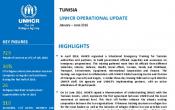Tunisia
Operation: Tunisia
Location
{"longitude":9,"latitude":34,"zoom_level":0}
Latest update of camps and office locations 13 Jan 2016. By clicking on the icons on the map, additional information is displayed.
Key Figures
| 2015 end-year results | |
| 300 | vulnerable refugees and asylum-seekers in urban areas received emergency assistance |
| 14 | working permits were granted to refugees by the Ministry of Employment |
| 66 | Syrian refugee children attended Tunisian schools |
Latest Updates
People of Concern
33%
Decrease in
2015
2015
| 2015 | 757 |
| 2014 | 1,135 |
| 2013 | 1,097 |

[["Refugees",665],["Asylum-seekers",90],["Others of concern",2]]
Loading ...
Budgets and Expenditure for Tunisia
< Back
2015
{"categories":[2012,2013,2014,2015,2016],"budget":[34.587051058,14.57865026,5.976656858,6.64456048,5.05078387],"expenditure":[11.96921357,8.20016582,4.41008572,3.59359927,null]}
{"categories":[2012,2013,2014,2015,2016],"p1":[34.587051058,14.57865026,5.976656858,6.64456048,5.05078387],"p2":[null,null,null,null,null],"p3":[null,null,null,null,null],"p4":[null,null,null,null,null]}
{"categories":[2012,2013,2014,2015,2016],"p1":[11.96921357,8.20016582,4.41008572,3.59359927,null],"p2":[null,null,null,null,null],"p3":[null,null,null,null,null],"p4":[null,null,null,null,null]}
Loading ...
CHOOSE A YEAR
- 2014
- 2015
- 2016
Working environment
- Tunisia faced significant security challenges, including three major terrorist attacks in 2015. The security situation remained unstable.
- UNHCR, together with Tunisian authorities and partners, began updating the inter-agency contingency plan owing to the unpredictable situation in Libya.
- UNHCR continued to play a leadership role on refugee and asylum issues, and planned to undertake a three-year project to support the Government to finalize a national asylum law.
Population trends
- There was a significant drop in the number of refugees and asylum-seekers, from approximately 1,100 at the beginning of 2015 to 760 at year end, as most pending asylum applications were processed and Syrians moved onward to Europe.
- The situation in Libya remained a potential source of arrivals, both by land and sea. In 2015, some 940 individuals travelling in seven boats were rescued at sea; among them were 150 asylum-seekers.
Achievements and impact
- Within the framework of the draft asylum law project, UNHCR continued to build the capacities of Tunisian authorities as well as other partners and non-governmental organizations; some 600 individuals received training or attended presentations on the principles of international protection.
- Refugees and asylum-seekers were able to access public health services and schools in Tunisia.
- Access to livelihood opportunities were improved as a result of the initiatives of UNHCR and implementing partners, such as assisting refugees to obtain work permits.
Unmet needs
- Education needs were not completely met in 2015. School grants provided to refugee children were minimal and did not cover all educational expenses. At times, language was also a barrier as the Tunisian curriculum is bilingual (Arabic and French).
- The medical needs of the Syrian refugees, many of whom were children, elderly or have other specific needs, were not adequately covered.
- Additional funding was needed to provide livelihood opportunities tailored for the needs of persons of concern.
Working environment
Three years after the 2011 socio-political upheaval that affected several countries in the region, Tunisia’s economy is still recovering and social issues remain of considerable concern. The country also faces significant security challenges, partly due to events elsewhere in the region.Nevertheless, the country has been able to broaden the protection space in North Africa, offering access to safety for thousands of people fleeing Libya in 2011, and developing a national protection system.
UNHCR is still undertaking refugee status determination (RSD) and providing assistance for refugees and asylum-seekers in Tunisia. Their presence is widely accepted by the authorities but a number of difficulties remain, including access to formal residence permits, employment and other livelihood activities. As a result, people of concern still face some protection risks as they do not have a legal status and encounter socio-economic challenges which affect their ability to be self-reliant in the country.
Tunisia is affected by events in neighbouring countries and the wider region. There is concern that recent developments in Libya could lead to influxes of people fleeing conflict, similar to the situation in 2011. Moreover, sea arrivals on Tunisia’s shores have been a continuous phenomenon since 2011, with an increase in departures from neighbouring Libya in 2013/2014. Tunisia has also received a number of Syrian refugees, arriving irregularly. The Government has not adopted any formal policy towards these two issues. Syrians are not sent back; however, they are not provided with documentation or any other forms of support by the Tunisian authorities. People rescued at sea are mainly assisted by international organizations and the Tunisian Red Crescent. Six boats were rescued off the Tunisian coasts in both 2013 and 2014, respectively.
The present context, with Libya being a destination for increased irregular migration movements and Tunisia a transit territory, risks affecting the engagement of the authorities with refugees and asylum-seekers. Nevertheless, the successive transitional Governments have upheld the objective of adopting a national asylum law. Refugee protection has also been enshrined in the newly adopted constitution, which foresees national legislation on this matter.
Needs and strategies
Pending the adoption of an asylum law in Tunisia, a priority for UNHCR will be to maintain sufficient capacity to conduct RSD while building national capacities to assure the international protection of refugees and asylum-seekers. UNHCR will also work to ensure that refugees are protected and granted access to public services in Tunisia. In this regard, support for local structures and organizations will be essential to provide protection and assistance, in particular for refugees and asylum-seekers with special needs.In 2015, UNHCR will pursue two main objectives: to assist Tunisia in adopting and setting up a comprehensive national protection system, which would allow authorities to progressively assume their responsibilities under the 1951 Refugee Convention; and – in a predominantly urban context – to carry out its mandate activities, using a community-based protection approach, with the support of relevant national and international actors.


